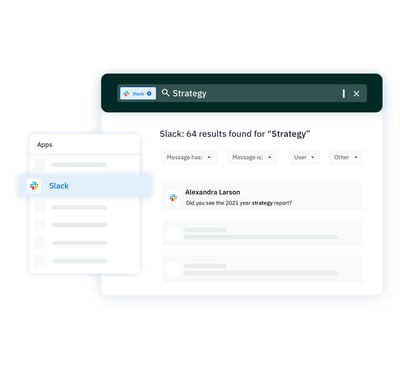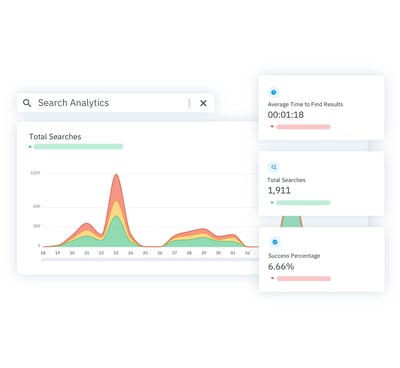
Jack Saville
9 mins read
Start building your digital home with Happeo
Request a demoIn the modern world of work, technologies that facilitate effective collaboration and communication are critical. Employees can no longer yell across the office or even visit another’s desk to get the information they need.
A pivotal study by McKinsey found that employees spend up to 1.8 hours per day — or 9.3 hours per week — searching and gathering information. That’s more than a whole workday wasted!
For most remote and hybrid workplaces, the adage “if it’s not recorded, it didn’t happen” lends insight into the chaos that typically reigns freely in enterprise communication and knowledge sharing online.
This is the exact problem an intuitive intranet search engine solves.
What is an intranet search engine?
An intranet search engine powers a company’s ability to store, access and share information with all its employees in a timely and efficient manner. It is a digital record of all the information and documents that are vital to the operations of a company.
Consider it like Google search for all of your company’s documents and information. Instead of searching public information available on the world wide web — aka the Internet — an intranet search engine operates on an internal level.
Your documents remain private and are only visible to those within the organization.
However, in order for an intranet search engine to be effective, it must do more than allow people to make a search. It must surface the most valuable information as quickly as possible.
Watch Happeo’s intranet search engine in action:
Understanding intranet search intent
In order to surface the most helpful information at the time your employees make a search, your intranet search solution must first understand how employees search for content.
Keyword searches
Keyword searches occur when an employee makes a search based on the general topic or tag that relates to the information they’re looking for.
These are the most common ways that people find information. For example, an employee looking for quarterly projections might type in “Q3 projections”.
File type searches
File searches offer employees the option to refine their search. For instance, there might be multiple files that contain mentions of the quarterly projections.
Searching for “Q3 projections” alongside a filter to only view spreadsheet files will refine the results and help them find the exact file they were after in a more intuitive and efficient way.
Author searches
Another common search pattern is searching by a document’s author. Two common ways author searches take place are:
- An employee looking for documents they’ve created; or
- Looking for a document someone else has authored.
Author searches save a lot of time and avoid the need to click through folders trying to figure out or remember where a file is stored.
Platform-specific searches
Some intranet search engines can integrate and synthesize information from a variety of platforms like Slack, Jira, Confluence, Google, Sharepoint, Microsoft and more.
In this case, employees may wish to filter the results of their search based on the platform they know the communication occurred in or that the document is stored in.
What to look for in an intranet search engine
By now you might be wondering what makes one intranet search engine better than another. Here’s what to look for if you want to boost productivity and engagement across your entire workforce.
Semantic, contextual and predictive search
There are different ways a search engine can make the decision on what information will be most helpful to your employees at the moment of their search.
- Semantic search: improves accuracy and relevance by factoring in the context and meaning of a search query. It can also understand typos or errors.
- Contextual search: offers personalized search results by taking into account a user’s search history and how frequently they access specific files.
- Predictive search: makes automatic suggestions for keywords or files to help a searcher find what they’re looking for before they even finish typing their query.
While many intranet search engines use semantic and contextual search practices, at Happeo, we take things a step further by leveraging all three approaches and making predictive search a central part of the experience.
Federated search
Say goodbye to searching through multiple platforms to find the right information. Those moments when an employee might have a vague idea of the information they’re looking for and they can’t quite remember what platform it was on can be very inefficient.
Where they would usually run multiple searches across Slack, Jira, ZenDesk and any other internal tools, federated search offers one search interface that delivers all the results.
With federated search, your search engine interface integrates with all your other essential tools to create an intuitive search experience anywhere and everywhere work happens in your organization.
Filterable search
Allowing people to filter for things like authors, file types and the platforms the information could be found in allows them to sift through thousands of documents in seconds. It also refines the search and helps unearth the specific information needed.

The best intranet search engines use filters to make it easy and intuitive for employees to find the exact thing they need without breaking the flow of their thoughts and attention mid-task.
Secure search
It goes without saying that your company intranet should be secure and follow the latest data privacy standards. However, you can also opt for a platform that gives you a finer degree of control and governance over who can find what information.
Key security features to consider include:
- Access control: authorize specific users to access certain data by synchronizing your Google Groups or Azure AD account
- Governance: run a tighter ship by controlling your intranet from a single intuitive admin panel
- Secure data storage: secure cloud storage allows your intranet to benefit from a highly-scalable infrastructure and top-class security protection
- Encryption: encoding data that is in transit to prevent unauthorized parties from accessing it
- Anonymization: anonymize results in order to prevent sensitive or personal information from leaking
- Accountability: configure your enterprise intranet to log all searches and actions to provide a clear accountability trail
- Compliance: ensure compliance with GDPR, ISO protocols and other security policies
- ISO 27001 Certification: this is the international standard for organizations to manage their information security
Data protection compliance is critical in any information storage system, especially with federated intranet searches that can access information across multiple platforms. That’s why at Happeo, we do not take security lightly.
Search analytics
Understanding how people search and exactly how much time they’re saving as a result of intuitive intranet search technologies is important. That’s where search analytics provides insights into things like:
- Unique search users: see how many individuals used the intranet search engine
- Time spent on opened results: see how long people spent on the search results page
- Success and failure rates: understand if people found what they needed
- Search terms: see exactly what your team is looking for
- Analytics filters: filter terms by department or organization unit
- Trending search terms: see what the most popular searches are at any time
- Average time to find results: see how long it takes to find information on average

Benefits of intranet search engines
The benefits of an intranet can be summed up in a series of micro-moments. Precious seconds and minutes are wasted when information is not easily accessible. On their own, such moments may not seem “that bad”. But when compounded over multiple moments a day per employee and then across your entire workforce, these micro-moments can have devastating effects on productivity.
Productivity and engagement are undoubtedly the top reasons to consider upgrading your intranet search engine to nip this snowball effect in the bud and to keep these micro-moments short and sweet, as your workers intended.
1. More productive employees
Productivity studies have found that 44% of the time, employees interrupt themselves. Time spent on the hunt for information is not only wasted time but also contributes to such self-interruptions that get in the way of productivity.
The faster your team can find data, the more productive they’ll be. You too can minimize the number of unnecessary interruptions and boost productivity thanks to the power of intuitive intranet search engines.
2. More engaged employees
No one wants to spend hours sifting through hundreds of files to find one small bit of relevant information.
Wasted time leads to lower employee engagement levels and mental fatigue. Wouldn’t it be better to repurpose their mental energy away from finding information and onto the tasks where they apply or analyze that information instead? Yeah, we think so too.
Keeping employees engaged and motivated becomes a whole lot easier when it’s more intuitive for them to find the information they need and can eliminate the frequent frustrations that come with poor intranet search experiences.
One search to rule them all
Not all intranet search engines come equal. But with the power of an intuitive intranet search engine that aims to save 20% of your employees’ time in your corner, your workforce can finally focus on more of the things that matter.
Critical features to consider for your intranet search engine include:
- Ability to search in multiple ways
- Intuitive filtering for authors, files types and platforms
- Integrated, federated search across all platforms where work happens
- Search analytics to analyze the success of your employees' search journeys
At Happeo, we optimize every aspect of intranet search in order to help your organization reclaim the time that’s typically wasted looking for information. Reach out if you’d like a demo of our innovative solution today!



